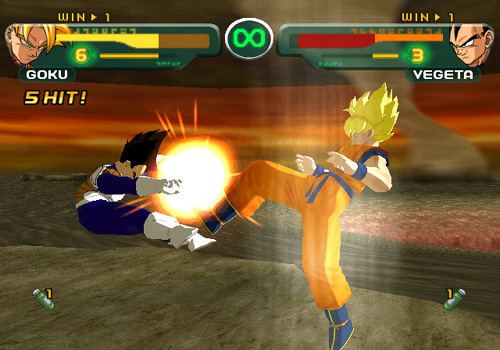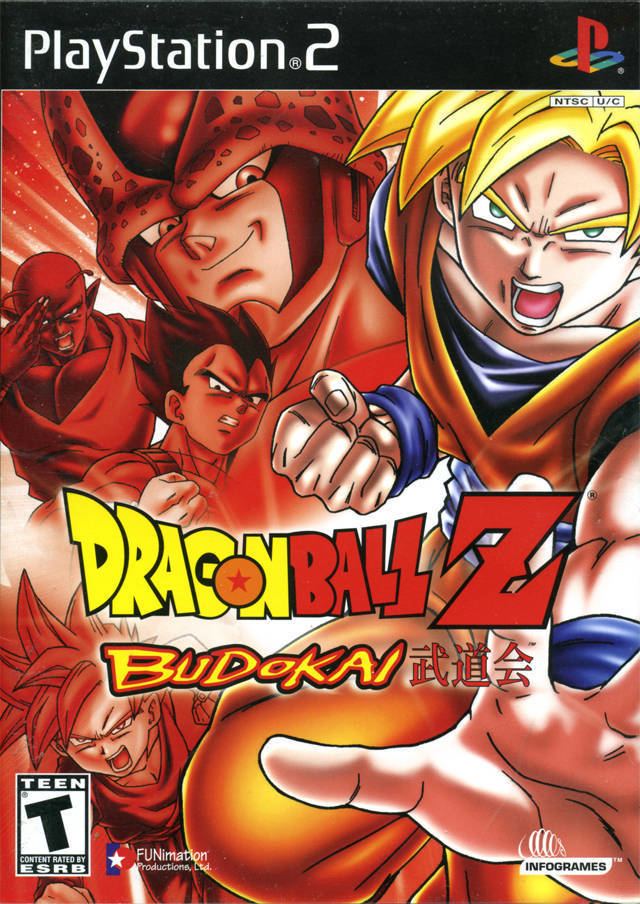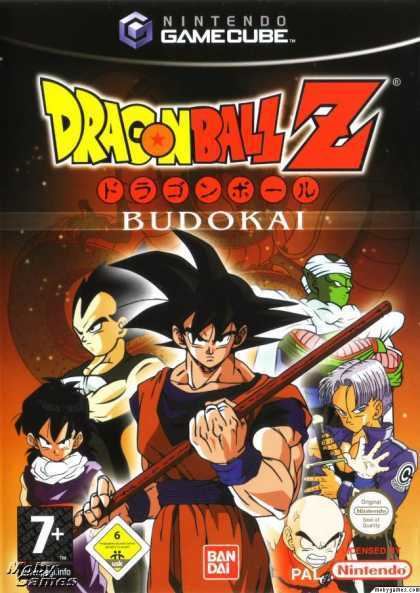Genres Fighting Genre Fighting game | Year of inception 2002 | |
 | ||
Publishers Platforms PlayStation 2PlayStation PortableGameCubePlayStation 3Xbox 360 Games Dragon Ball Z: Infinite W, Dragon Ball Z: Burst Limit, Dragon Ball Z Shin Budokai, Dragon Ball Z: Shin Budokai, Dragon Ball Z: Budokai 3 | ||
Cgrundertow dragon ball z budokai for nintendo gamecube video game review
Dragon Ball Z: Budokai (武道会) is a series of fighting video games based on the anime series Dragon Ball Z.
Contents
- Cgrundertow dragon ball z budokai for nintendo gamecube video game review
- Ps2 longplay 014 dragon ball z budokai
- Gameplay
- Budokai
- Budokai 2
- Dragon Ball Z 2 V
- Budokai 3
- Shin Budokai
- Shin Budokai Another Road
- Infinite World
- Budokai HD Collection
- References

Ps2 longplay 014 dragon ball z budokai
Gameplay

The Budokai series plays like a typical 3-D fighting game. As well as including the regular punch and kick buttons, there is the ability to shoot Ki blasts, which can also be used in specific special moves. The special moves are mainly taken from individual characters own special moves from the show; including, but not limited to, Goku's Kamehameha, Vegeta's Galick Gun and Frieza's Death Beam. Although these mechanics have stuck with the series, other ideas such as the "Hyper Mode" the ability to move at incredible speeds, fly freely, and "Beam Struggles" between two character's beam attacks. were later replaced in favour of other techniques.
Budokai

Dragon Ball Z: Budokai, released as Dragon Ball Z (ドラゴンボールZ, Doragon Bōru Zetto) in Japan, is a fighting game released for the PlayStation 2 on November 2, 2002, in Europe and on December 3, 2002, in North America, and for the Nintendo GameCube on October 28, 2003, in North America and on November 14, 2003, in Europe. It was the first Budokai game of the series but also the first Dragon Ball Z game to be released in all Europe and aside from specific releases in France, Spain and Portugal like it was with the earlier games. The game was released in Japan by Bandai on the PlayStation 2 on February 13, 2003, and on the Nintendo GameCube on November 28, 2003. It was developed by Dimps and published by Infogrames and later by Atari as a Greatest Hits title for the PlayStation 2 in North America.
The game follows the Dragon Ball Z timeline starting with Goku and Piccolo's fight with Raditz up to Gohan's final battle with Cell with a total of 23 playable characters. Features included in the game were a story mode, a versus mode, a tournament stage, a practice mode, and an items shop which allowed the player to purchase various customization abilities using money that was gained through the various challenges in the story mode and tournament victories to customize and make the most powerful warriors. The story mode also included a few "what if" episodes to play, retelling iconic events in the Dragon Ball history with a few twists. A cel-shading effect was added to the graphics in the GameCube version.

The North American versions feature English voice acting from the North American Funimation dub, while the European versions feature the original Japanese voice acting and several European languages text translations.
Budokai 2
Dragon Ball Z: Budokai 2, released as Dragon Ball Z 2 (ドラゴンボールZ2, Doragon Bōru Zetto Tsū) in Japan, is a fighting game based upon the popular anime series, Dragon Ball Z. Budokai 2 is a sequel to Dragon Ball Z: Budokai and was developed by Dimps and published by Atari for the PlayStation 2 and Nintendo GameCube. It was released for the PlayStation 2 in North America on December 4, 2003, and on the Nintendo GameCube on December 15, 2004. The game was published in Japan by Bandai, and released for the PlayStation 2 on February 5, 2004.
The game's features include a tournament stage, versus mode, and an item shop. The story mode in the game is known as Dragon World, and plays like a board game as the player assembles a team of Z-fighters to challenge the various enemies in the series starting from the Saiyan Saga up to the final Kid Buu Saga. The game has a total of 31 playable characters including fusions of different fighters, and Majin Buu's various forms. The Japanese version of the game added several new costumes, as well as a new stage in the game's story mode. Some of the added costumes were added to the North American release of the GameCube version.
Once again, the North American versions feature English voice acting from the North American Funimation dub. The European PlayStation 2 version also features it, while the later European GameCube version switched back to the original Japanese voice acting because of negative feedback from most European Dragon Ball fans which were used to the Japanese dub since the 16-bit era.
Dragon Ball Z 2 V
In Japan, 2,000 lucky V-Jump readers got Dragon Ball Z 2 V, a revamped version of Dragon Ball Z: Budokai 2 with Cooler, Kuriza, Majin Frieza, and Majin Cell included. All of the characters were already unlocked, but the capsules were preset. The World Martial Arts Tournament now displays the "V-Jump" logo.
The logo for the game was slightly changed. In addition to a "V", mostly likely to emulate the "V" in V-Jump, Cooler poses near the "D" in Dragon Ball Z.
Budokai 3
Dragon Ball Z: Budokai 3, released as Dragon Ball Z 3 (ドラゴンボールZ3, Doragon Bōru Zetto Surī) in Japan, is a video game based on the popular anime series Dragon Ball Z and was developed by Dimps and published by Atari for the PlayStation 2. It was released on November 16, 2004, in North America in both a standard and Limited Edition release, the latter of which included a DVD featuring a behind the scenes looks at the game's development. In Europe, it was released on November 19, 2004.
The game's story mode yet again plays through the events of the Dragon Ball Z timeline, and the game includes several characters and events from the Dragon Ball Z movies (like Cooler, Broly and Bardock), Dragon Ball GT (like Super Saiyan 4 and Omega Shenron), and the original Dragon Ball series itself (Kid Goku). Other features the game includes are a versus mode, an items shop, a tournament, and a battle ranking stage where the player has to challenge the AI in a hundred fighter challenge. Moving a spot above after beating who ever is next in the ranking. The fighting mechanics have also been enhanced from the preceding 2 games making the game closer to its anime counterpart in terms of combat (which was well received by fans of the series and gamers alike). Budokai 3 has a roster of 42 playable characters in recent releases of the game.
The game was released in Japan by Bandai on February 10, 2005. Like Budokai 2 before it, the Japanese version of Budokai 3 added several costumes not present in the North American and European versions. The North American Greatest Hits version of Budokai 3 adds these costumes, as well as the option to switch the audio to Japanese for the first time in North America. This version was also released in Europe as a re-release of the game under the title Dragon Ball Z: Budokai 3 - Director's Cut. From this release onwards, all Dragon Ball Z games in North America and Europe were released with dual voice language options in English and Japanese in order to please all fans.
Shin Budokai
Dragon Ball Z: Shin Budokai (ドラゴンボールZ 真武道会, Doragon Bōru Zetto Shin Budôkai, Dragon Ball Z: True Tournament) is a fighting video game part of the Dragon Ball Z franchise, developed by Dimps and released in North America on March 7, 2006, and in Europe on May 25, 2006, for the PlayStation Portable. The game's story mode is based on the events of the movie Dragon Ball Z: Fusion Reborn. The choices the player makes in the story determine how the story evolves.
Another mode is the Arcade mode, a single-player mode that lets you brawl against the CPU in order to fight and gain the Dragon Balls. Next is the Z trial mode, which consists of two different types of play: survival, where you fight against CPU-controlled opponents for as long as you can, and time attack, where you see how fast you can make it through a predetermined set of opponents.
Finally, there’s the Profile Card mode in which the players will have their in-game character profile cards that lists their name and power level. The player can design their own card and customize them with the items from the game's item store.
Shin Budokai - Another Road
Dragon Ball Z: Shin Budokai - Another Road (known simply as Dragon Ball Z: Shin Budokai 2 (ドラゴンボールZ 真武道会2, Doragon Bōru Zetto Shin Budôkai Tzū, Dragon Ball Z: True Tournament 2) in Japan and Europe) is the sequel to Dragon Ball Z: Shin Budokai for the PlayStation Portable. The game features a brand new story that tells the tale of Majin Buu being released in Future Trunks' timeline. As Majin Buu is too strong for Trunks to handle alone, he uses his time machine to recruit the original Z warriors for assistance, eventually succeeding in the destruction of Majin Buu.
Infinite World
Dragon Ball Z: Infinite World is the fourth installment to the Budokai PS2 series. The game was released on December 4, 2008, in Japan, November 4, 2008, in North America and December 5, 2008, in Europe.
Budokai: HD Collection
Dragon Ball Z: Budokai HD Collection includes re-mastered versions of Budokai and Budokai 3, alongside full Trophy and Achievements support. Both games include the optional original Japanese language track. Both games also feature new soundtracks consisting of soundtracks by Shunsuke Kikuchi, whereas the soundtracks from the original PS2 versions were made by Kenji Yamamoto. This is because Yamamoto had used actual songs as bases for the tracks he made for the Dragon Ball Z games he worked on, as well as Dragon Ball Kai were replaced by Shunsuke's scores. Yamamoto was fired by Toei Animation in 2011, and all the soundtracks he did for the Dragon Ball Z games and Dragon Ball Z Kai (the HD anime remaster of Dragon Ball Z) were replaced by Shunsuke's scores. The game was released in Europe on November 2, 2012, and in North America on November 6, 2012, for PlayStation 3 and Xbox 360.
Budokai
The first Budokai received "mixed or average" reviews on both platforms according to the review aggregation website Metacritic. Entertainment Weekly gave the PlayStation 2 version a C and said that its characters, "while lacking artistic detail, still yell, grunt, and move almost exactly like their broadcast counterparts."
Many critics complained about the GameCube version's simple interface and the fact that combos weren't worth the payoff. However, more complex combos were possible due to an oversight in the move canceling feature but were rarely known at the time. These oversights were turned into an important part of the system in the later games and were what high level play tended to revolve around.
Budokai 2
Budokai 2 received "average" reviews on both platforms according to Metacritic. GameSpot said of the PS2 version: "The improved visuals are nice, and some of the additions made to the fighting system are fun, but Budokai 2 still comes out as an underwhelming sequel."
Budokai 3
Budokai 3 was given much higher reviews than its predecessors Budokai and Budokai 2 according to Metacritic. This was often due to how critics felt that the game did more to improve its gameplay rather than just its graphics and presentation. Its fighting and graphics have also been praised, with IGN stating that Budokai 3 was "One of the few instances of cel-shading done right", and that it "also offers a healthy amount of special effects and pyrotechnics and they all look great."
Shin Budokai
Shin Budokai received "average" reviews according to Metacritic. In Japan, Famitsu gave it a score of one eight, one seven, one six, and one seven, for a total of 28 out of 40.
Shin Budokai - Another Road
Shin Budokai - Another Road received "mixed" reviews according to Metacritic. In Japan, Famitsu gave it a score of one six, one five, and two sevens for a total of 25 out of 40.
Budokai: HD Collection
Budokai: HD Collection received "mixed" reviews on both platforms according to Metacritic.
